FIN600 Financial Management: Resolute Mining Company Analysis Report
VerifiedAdded on 2023/05/29
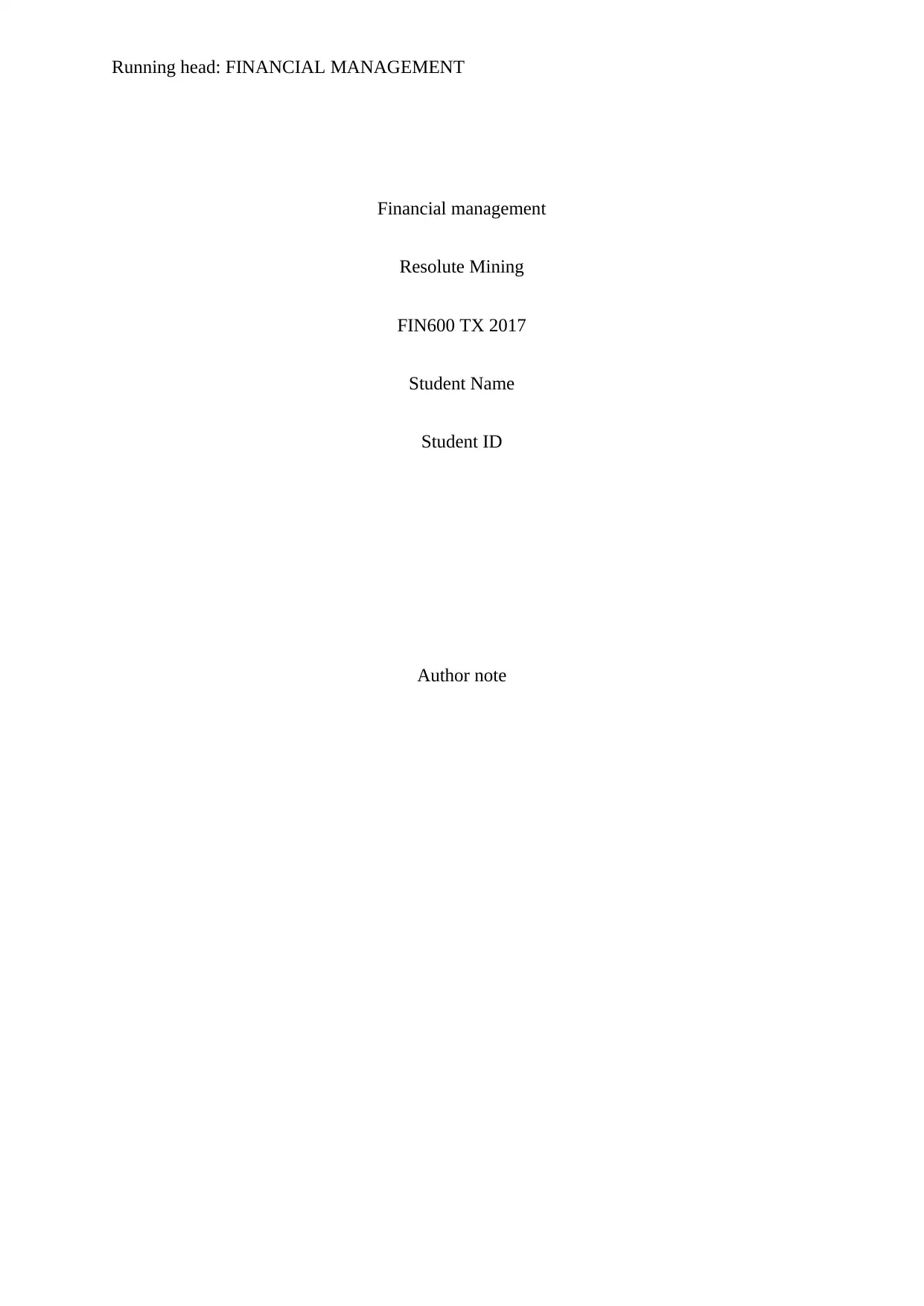
Financial management
Resolute Mining
FIN600 TX 2017
Student Name
Student ID
Author note
Paraphrase This Document
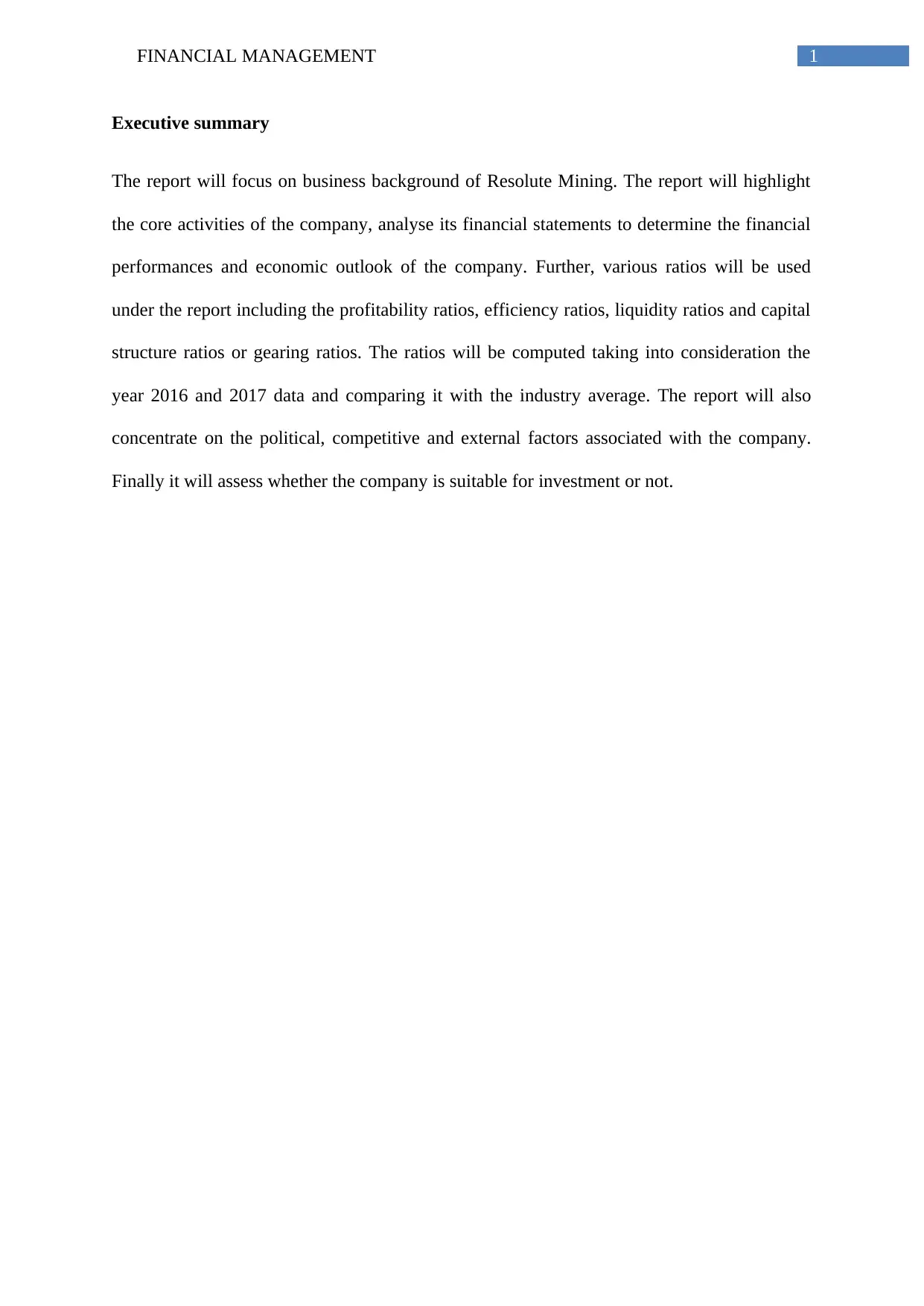
Executive summary
The report will focus on business background of Resolute Mining. The report will highlight
the core activities of the company, analyse its financial statements to determine the financial
performances and economic outlook of the company. Further, various ratios will be used
under the report including the profitability ratios, efficiency ratios, liquidity ratios and capital
structure ratios or gearing ratios. The ratios will be computed taking into consideration the
year 2016 and 2017 data and comparing it with the industry average. The report will also
concentrate on the political, competitive and external factors associated with the company.
Finally it will assess whether the company is suitable for investment or not.
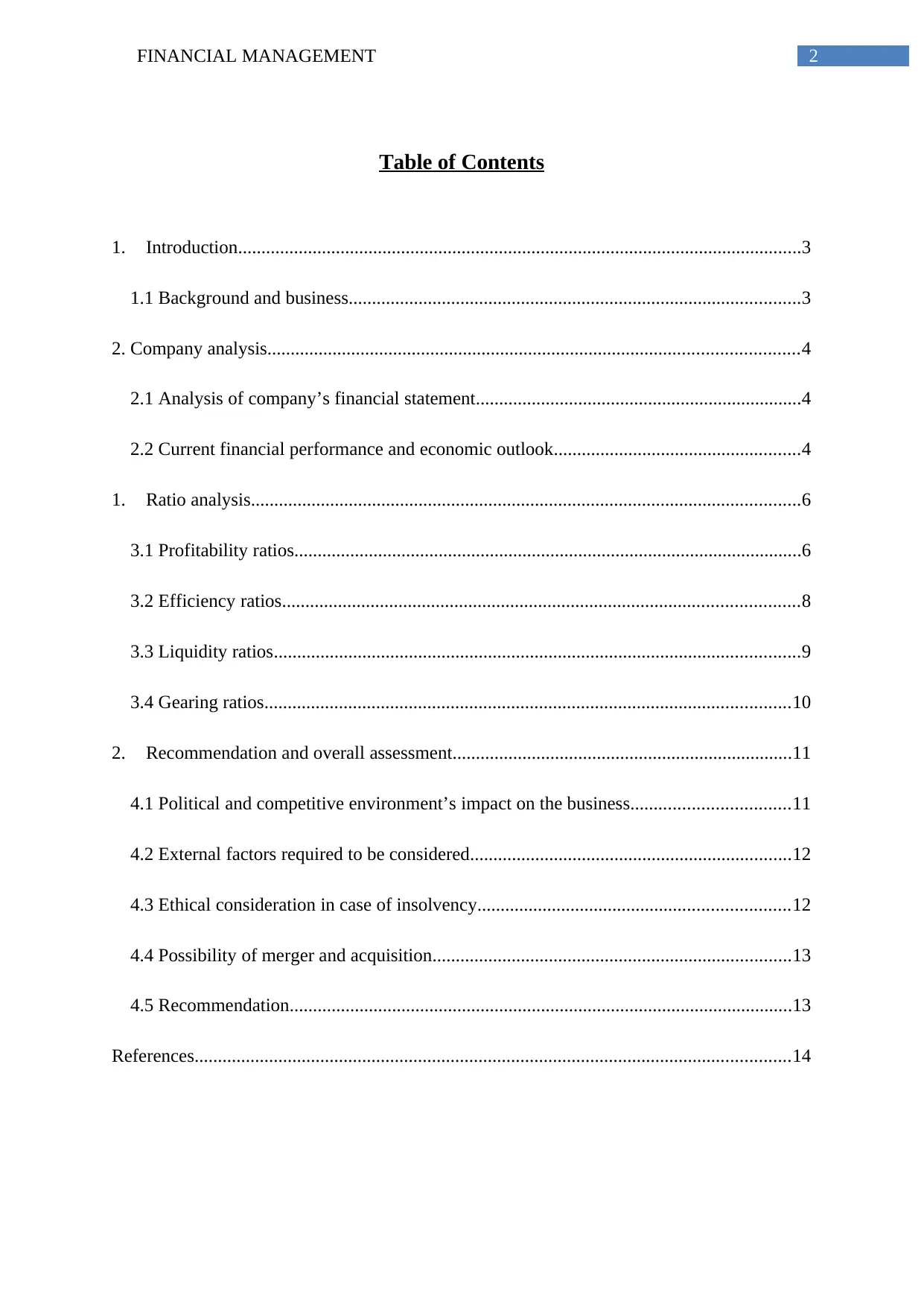
Table of Contents
1. Introduction.........................................................................................................................3
1.1 Background and business.................................................................................................3
2. Company analysis..................................................................................................................4
2.1 Analysis of company’s financial statement......................................................................4
2.2 Current financial performance and economic outlook.....................................................4
1. Ratio analysis......................................................................................................................6
3.1 Profitability ratios.............................................................................................................6
3.2 Efficiency ratios...............................................................................................................8
3.3 Liquidity ratios.................................................................................................................9
3.4 Gearing ratios.................................................................................................................10
2. Recommendation and overall assessment.........................................................................11
4.1 Political and competitive environment’s impact on the business..................................11
4.2 External factors required to be considered.....................................................................12
4.3 Ethical consideration in case of insolvency...................................................................12
4.4 Possibility of merger and acquisition.............................................................................13
4.5 Recommendation............................................................................................................13
References................................................................................................................................14
⊘ This is a preview!⊘
Do you want full access?
Subscribe today to unlock all pages.

Trusted by 1+ million students worldwide
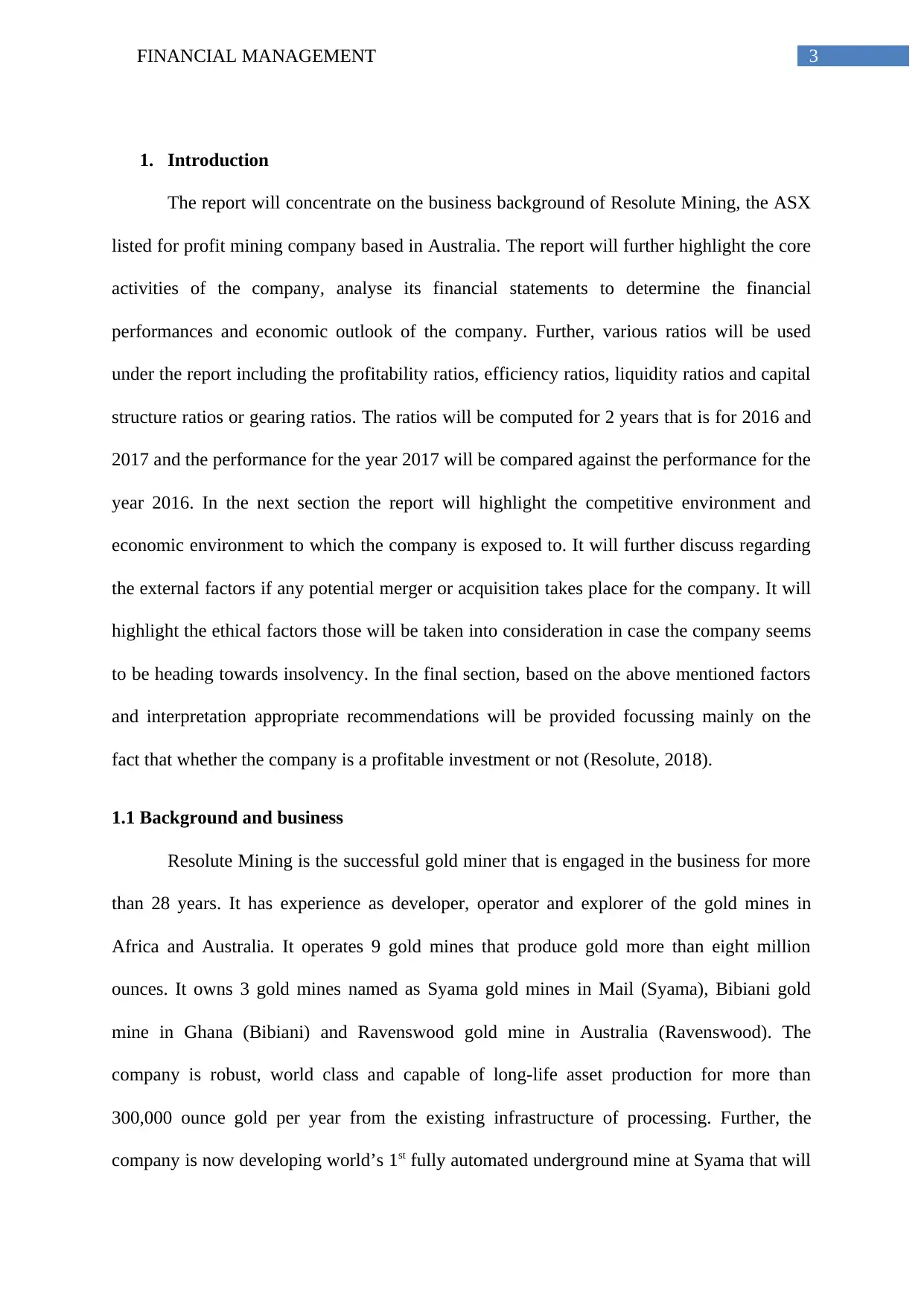
1. Introduction
The report will concentrate on the business background of Resolute Mining, the ASX
listed for profit mining company based in Australia. The report will further highlight the core
activities of the company, analyse its financial statements to determine the financial
performances and economic outlook of the company. Further, various ratios will be used
under the report including the profitability ratios, efficiency ratios, liquidity ratios and capital
structure ratios or gearing ratios. The ratios will be computed for 2 years that is for 2016 and
2017 and the performance for the year 2017 will be compared against the performance for the
year 2016. In the next section the report will highlight the competitive environment and
economic environment to which the company is exposed to. It will further discuss regarding
the external factors if any potential merger or acquisition takes place for the company. It will
highlight the ethical factors those will be taken into consideration in case the company seems
to be heading towards insolvency. In the final section, based on the above mentioned factors
and interpretation appropriate recommendations will be provided focussing mainly on the
fact that whether the company is a profitable investment or not (Resolute, 2018).
1.1 Background and business
Resolute Mining is the successful gold miner that is engaged in the business for more
than 28 years. It has experience as developer, operator and explorer of the gold mines in
Africa and Australia. It operates 9 gold mines that produce gold more than eight million
ounces. It owns 3 gold mines named as Syama gold mines in Mail (Syama), Bibiani gold
mine in Ghana (Bibiani) and Ravenswood gold mine in Australia (Ravenswood). The
company is robust, world class and capable of long-life asset production for more than
300,000 ounce gold per year from the existing infrastructure of processing. Further, the
company is now developing world’s 1st fully automated underground mine at Syama that will
Paraphrase This Document

provide low cost and target scale operation by the end of the year 2032. Further, the company
is focussed on the growth through development and exploration and it is active with regard to
review of new opportunities for building the shareholder’s value (Resolute, 2018).
2. Company analysis
2.1 Analysis of company’s financial statement
Looking into the financial statement of the company for the year ended 30th June 2017
it is identified that the general purpose financial report of the company is prepared as per the
AAS (Australian accounting standards), authoritative pronouncement of AAB (Australian
accounting board) and Corporation Act 2001. Further, the financial reports are complied with
the AAS issued by AASB (Australian accounting standards board) and IFRS (international
financial reporting standards) issued by IASB (international accounting standards board)
(Easton & Sommers, 2018). Financial statement of the company comprises of 4 financial
statements –
Consolidated statement of comprehensive income
Consolidated statement of financial position
Consolidated statement of changes in equity
Consolidated statement of the cash flows
2.2 Current financial performance and economic outlook
Through analysis of the company’s financial statement it can be stated that the
revenue of the company has been reduced from $ 554, 624,000 to $ 541,177,000 from the
year 2016 to 2017. However, the company was able to reduce its COGS ratio and resulted
into higher gross profit as compared to the previous year. Revenue from silver and gold is the
major source of income for the company and it expensed significant amount towards
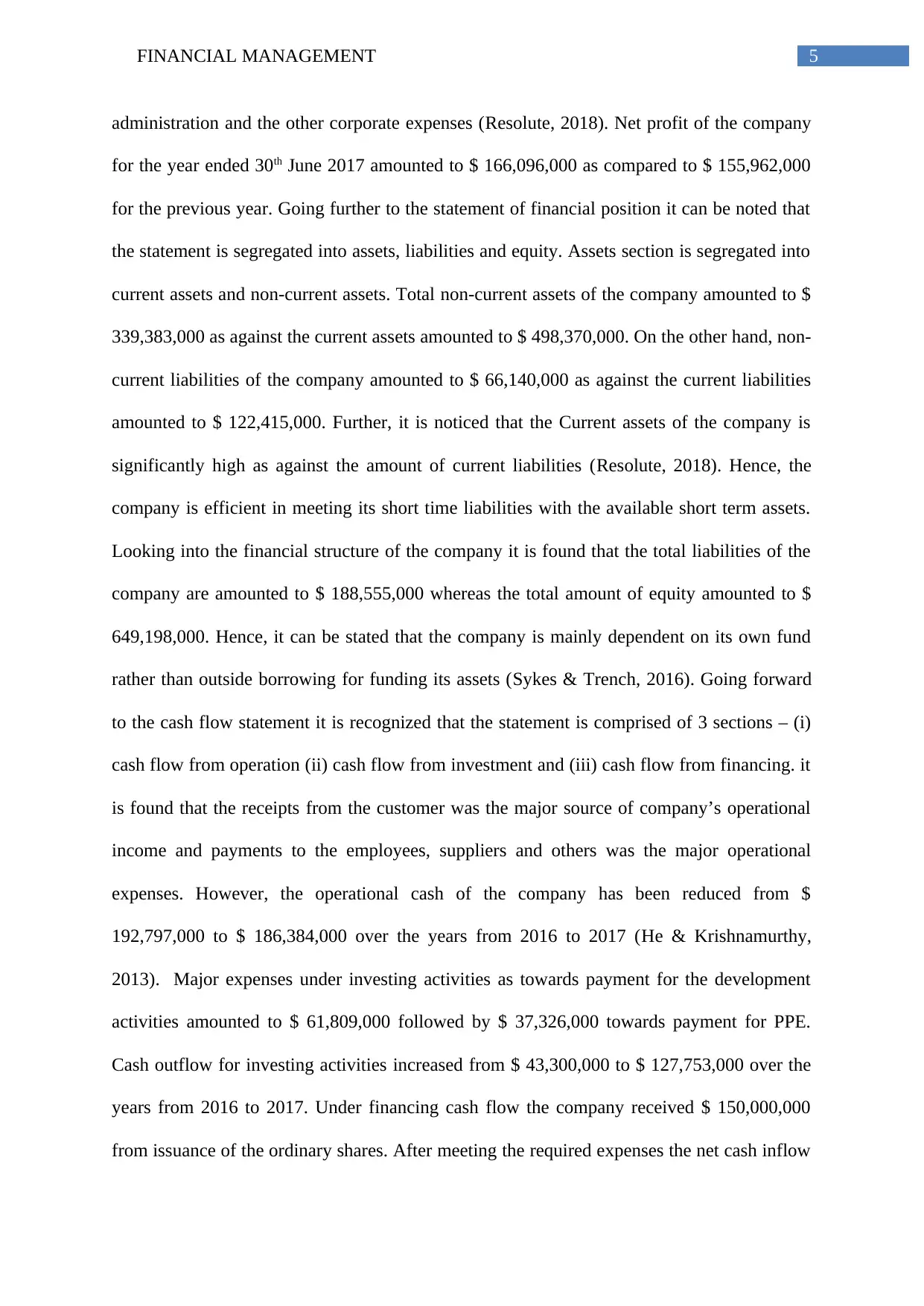
administration and the other corporate expenses (Resolute, 2018). Net profit of the company
for the year ended 30th June 2017 amounted to $ 166,096,000 as compared to $ 155,962,000
for the previous year. Going further to the statement of financial position it can be noted that
the statement is segregated into assets, liabilities and equity. Assets section is segregated into
current assets and non-current assets. Total non-current assets of the company amounted to $
339,383,000 as against the current assets amounted to $ 498,370,000. On the other hand, non-
current liabilities of the company amounted to $ 66,140,000 as against the current liabilities
amounted to $ 122,415,000. Further, it is noticed that the Current assets of the company is
significantly high as against the amount of current liabilities (Resolute, 2018). Hence, the
company is efficient in meeting its short time liabilities with the available short term assets.
Looking into the financial structure of the company it is found that the total liabilities of the
company are amounted to $ 188,555,000 whereas the total amount of equity amounted to $
649,198,000. Hence, it can be stated that the company is mainly dependent on its own fund
rather than outside borrowing for funding its assets (Sykes & Trench, 2016). Going forward
to the cash flow statement it is recognized that the statement is comprised of 3 sections – (i)
cash flow from operation (ii) cash flow from investment and (iii) cash flow from financing. it
is found that the receipts from the customer was the major source of company’s operational
income and payments to the employees, suppliers and others was the major operational
expenses. However, the operational cash of the company has been reduced from $
192,797,000 to $ 186,384,000 over the years from 2016 to 2017 (He & Krishnamurthy,
2013). Major expenses under investing activities as towards payment for the development
activities amounted to $ 61,809,000 followed by $ 37,326,000 towards payment for PPE.
Cash outflow for investing activities increased from $ 43,300,000 to $ 127,753,000 over the
years from 2016 to 2017. Under financing cash flow the company received $ 150,000,000
from issuance of the ordinary shares. After meeting the required expenses the net cash inflow
⊘ This is a preview!⊘
Do you want full access?
Subscribe today to unlock all pages.

Trusted by 1+ million students worldwide
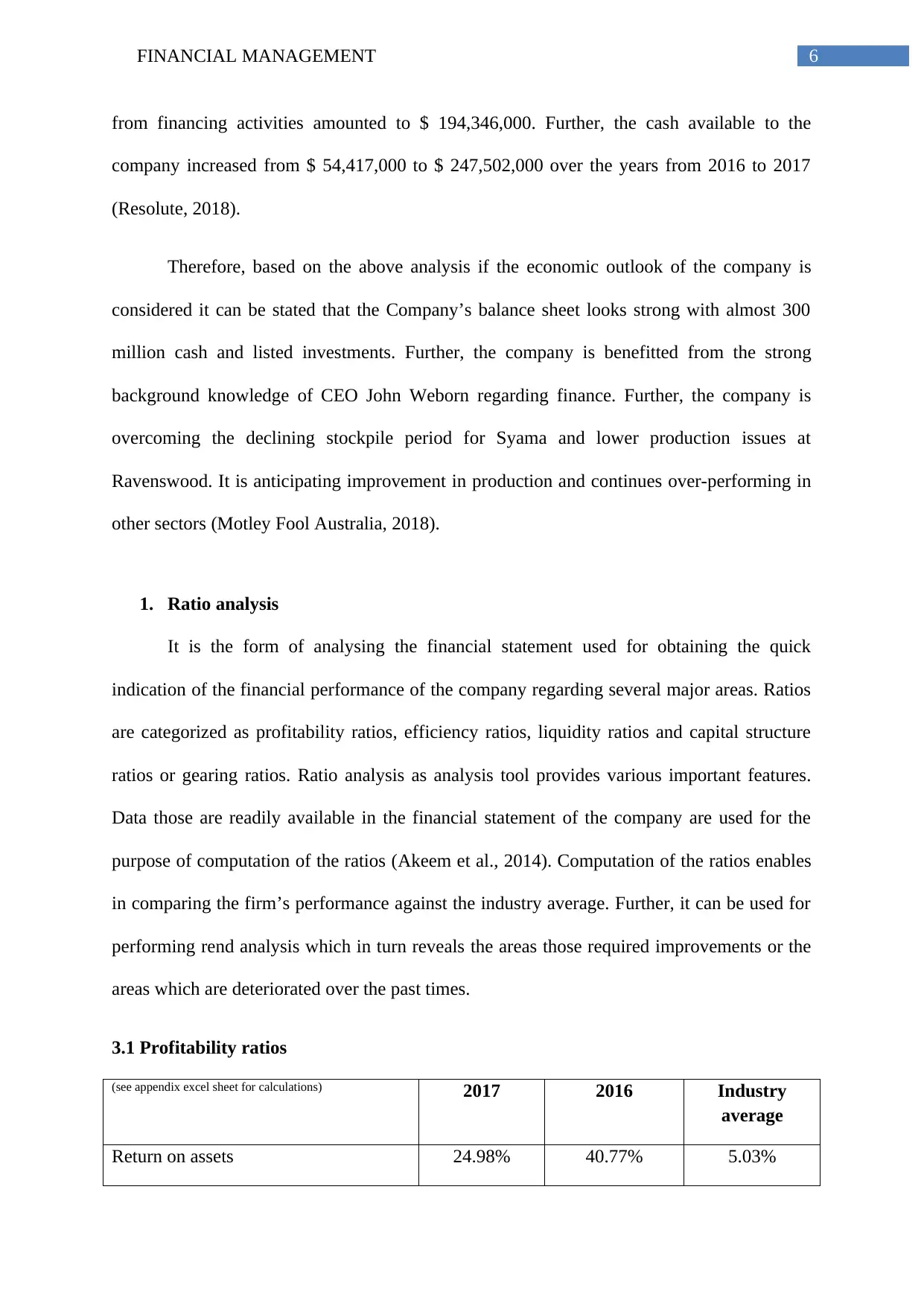
from financing activities amounted to $ 194,346,000. Further, the cash available to the
company increased from $ 54,417,000 to $ 247,502,000 over the years from 2016 to 2017
(Resolute, 2018).
Therefore, based on the above analysis if the economic outlook of the company is
considered it can be stated that the Company’s balance sheet looks strong with almost 300
million cash and listed investments. Further, the company is benefitted from the strong
background knowledge of CEO John Weborn regarding finance. Further, the company is
overcoming the declining stockpile period for Syama and lower production issues at
Ravenswood. It is anticipating improvement in production and continues over-performing in
other sectors (Motley Fool Australia, 2018).
1. Ratio analysis
It is the form of analysing the financial statement used for obtaining the quick
indication of the financial performance of the company regarding several major areas. Ratios
are categorized as profitability ratios, efficiency ratios, liquidity ratios and capital structure
ratios or gearing ratios. Ratio analysis as analysis tool provides various important features.
Data those are readily available in the financial statement of the company are used for the
purpose of computation of the ratios (Akeem et al., 2014). Computation of the ratios enables
in comparing the firm’s performance against the industry average. Further, it can be used for
performing rend analysis which in turn reveals the areas those required improvements or the
areas which are deteriorated over the past times.
3.1 Profitability ratios
(see appendix excel sheet for calculations) 2017 2016 Industry
average
Return on assets 24.98% 40.77% 5.03%
Paraphrase This Document
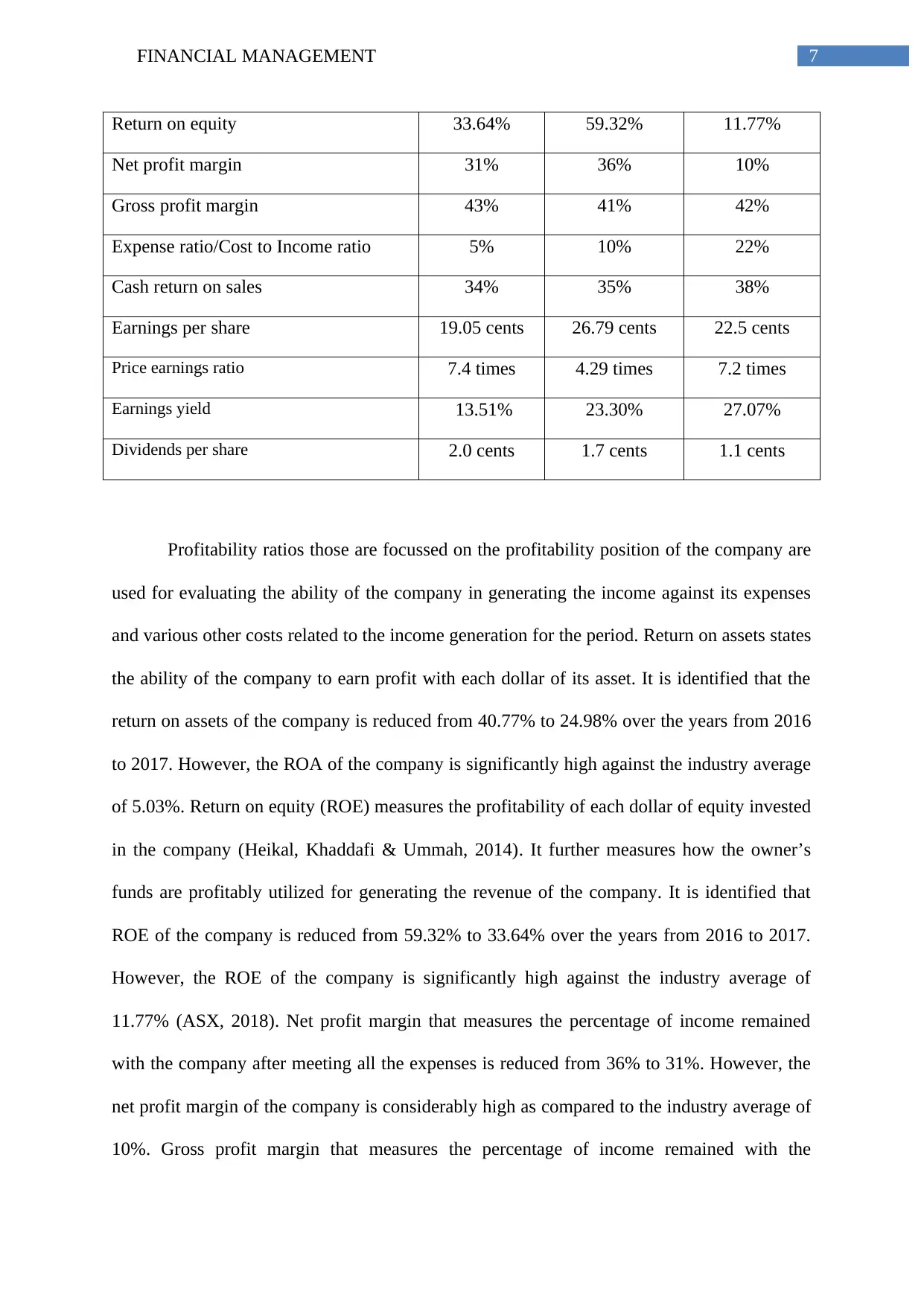
Return on equity 33.64% 59.32% 11.77%
Net profit margin 31% 36% 10%
Gross profit margin 43% 41% 42%
Expense ratio/Cost to Income ratio 5% 10% 22%
Cash return on sales 34% 35% 38%
Earnings per share 19.05 cents 26.79 cents 22.5 cents
Price earnings ratio 7.4 times 4.29 times 7.2 times
Earnings yield 13.51% 23.30% 27.07%
Dividends per share 2.0 cents 1.7 cents 1.1 cents
Profitability ratios those are focussed on the profitability position of the company are
used for evaluating the ability of the company in generating the income against its expenses
and various other costs related to the income generation for the period. Return on assets states
the ability of the company to earn profit with each dollar of its asset. It is identified that the
return on assets of the company is reduced from 40.77% to 24.98% over the years from 2016
to 2017. However, the ROA of the company is significantly high against the industry average
of 5.03%. Return on equity (ROE) measures the profitability of each dollar of equity invested
in the company (Heikal, Khaddafi & Ummah, 2014). It further measures how the owner’s
funds are profitably utilized for generating the revenue of the company. It is identified that
ROE of the company is reduced from 59.32% to 33.64% over the years from 2016 to 2017.
However, the ROE of the company is significantly high against the industry average of
11.77% (ASX, 2018). Net profit margin that measures the percentage of income remained
with the company after meeting all the expenses is reduced from 36% to 31%. However, the
net profit margin of the company is considerably high as compared to the industry average of
10%. Gross profit margin that measures the percentage of income remained with the
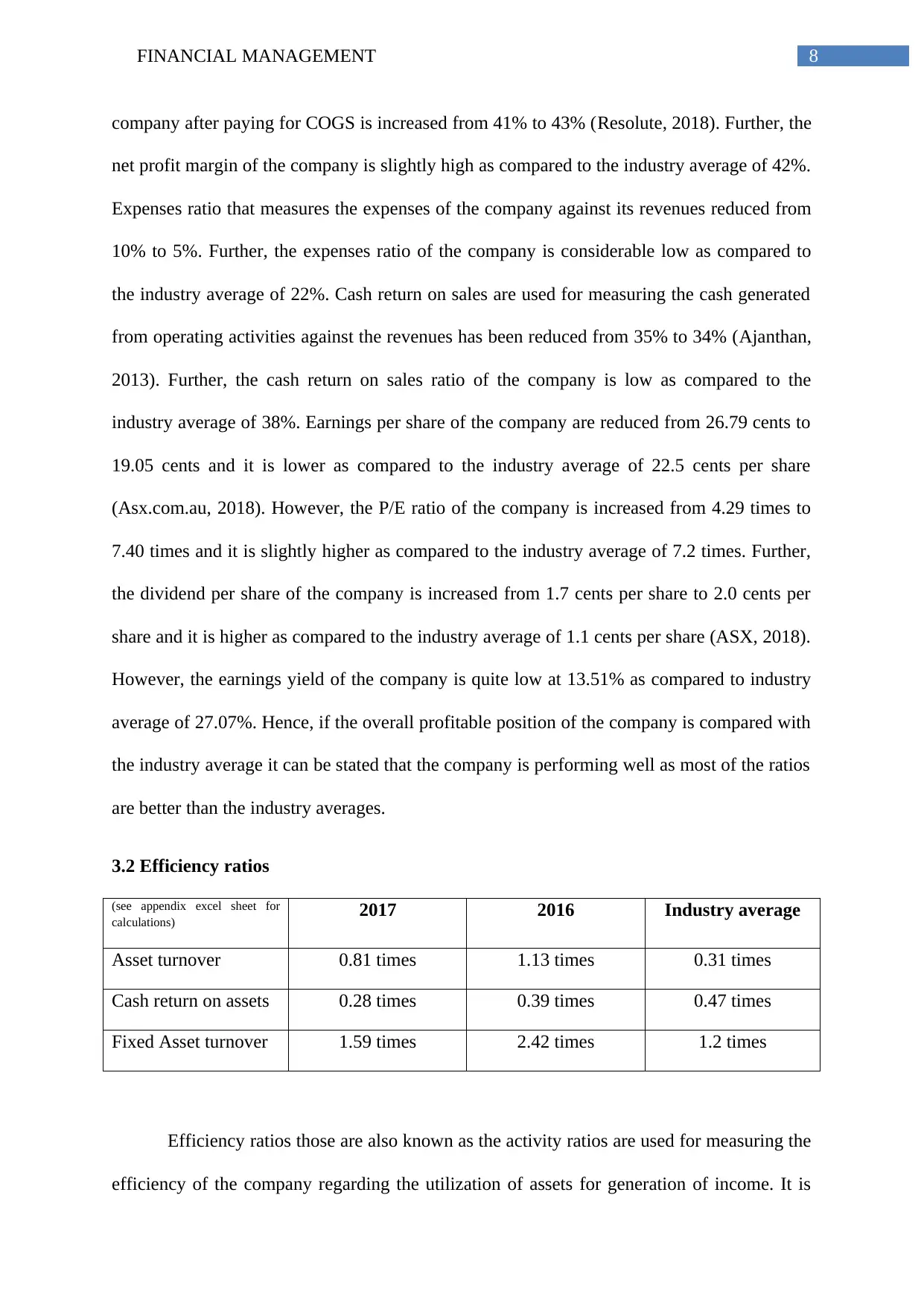
company after paying for COGS is increased from 41% to 43% (Resolute, 2018). Further, the
net profit margin of the company is slightly high as compared to the industry average of 42%.
Expenses ratio that measures the expenses of the company against its revenues reduced from
10% to 5%. Further, the expenses ratio of the company is considerable low as compared to
the industry average of 22%. Cash return on sales are used for measuring the cash generated
from operating activities against the revenues has been reduced from 35% to 34% (Ajanthan,
2013). Further, the cash return on sales ratio of the company is low as compared to the
industry average of 38%. Earnings per share of the company are reduced from 26.79 cents to
19.05 cents and it is lower as compared to the industry average of 22.5 cents per share
(Asx.com.au, 2018). However, the P/E ratio of the company is increased from 4.29 times to
7.40 times and it is slightly higher as compared to the industry average of 7.2 times. Further,
the dividend per share of the company is increased from 1.7 cents per share to 2.0 cents per
share and it is higher as compared to the industry average of 1.1 cents per share (ASX, 2018).
However, the earnings yield of the company is quite low at 13.51% as compared to industry
average of 27.07%. Hence, if the overall profitable position of the company is compared with
the industry average it can be stated that the company is performing well as most of the ratios
are better than the industry averages.
3.2 Efficiency ratios
(see appendix excel sheet for
calculations) 2017 2016 Industry average
Asset turnover 0.81 times 1.13 times 0.31 times
Cash return on assets 0.28 times 0.39 times 0.47 times
Fixed Asset turnover 1.59 times 2.42 times 1.2 times
Efficiency ratios those are also known as the activity ratios are used for measuring the
efficiency of the company regarding the utilization of assets for generation of income. It is
⊘ This is a preview!⊘
Do you want full access?
Subscribe today to unlock all pages.

Trusted by 1+ million students worldwide
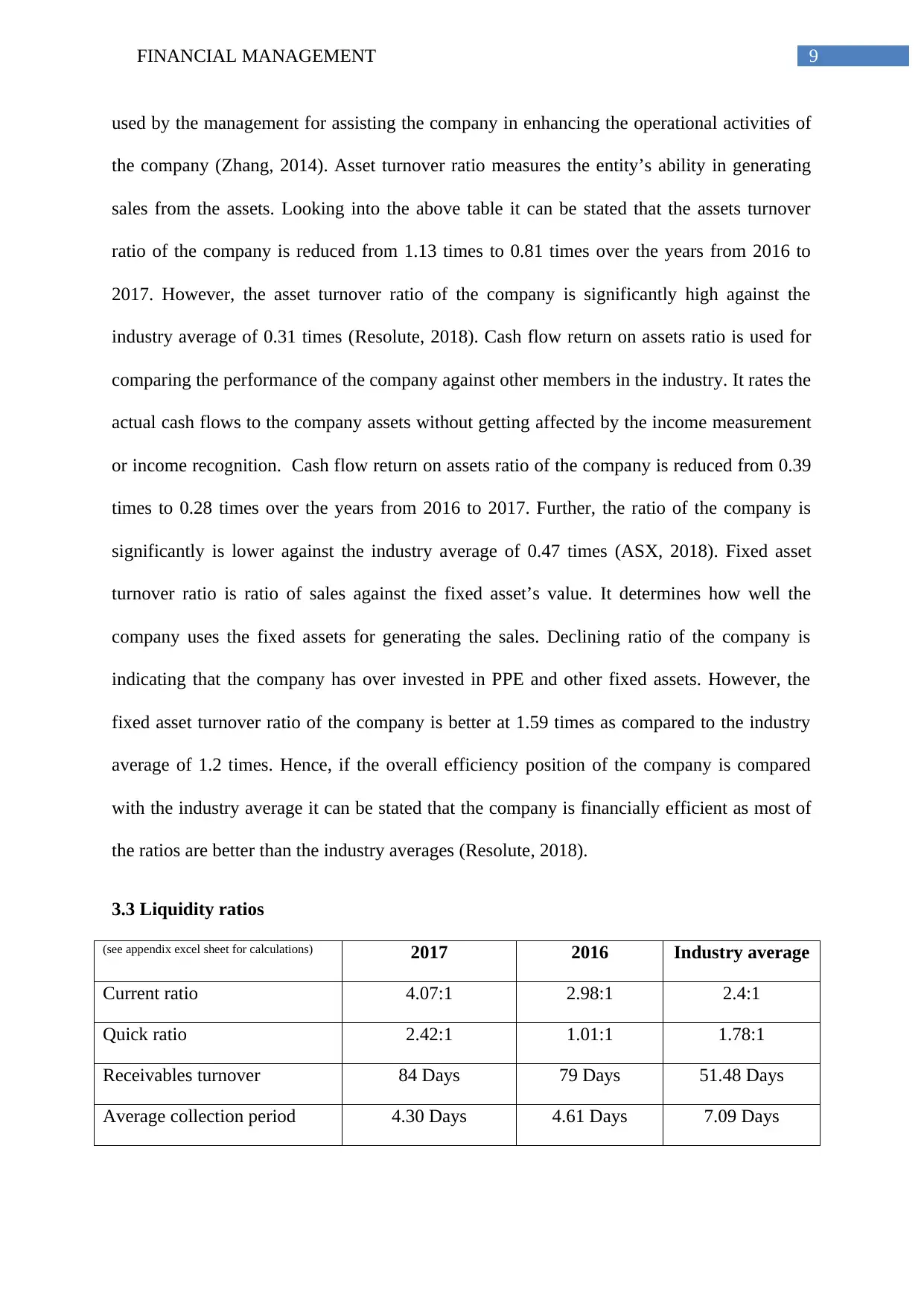
used by the management for assisting the company in enhancing the operational activities of
the company (Zhang, 2014). Asset turnover ratio measures the entity’s ability in generating
sales from the assets. Looking into the above table it can be stated that the assets turnover
ratio of the company is reduced from 1.13 times to 0.81 times over the years from 2016 to
2017. However, the asset turnover ratio of the company is significantly high against the
industry average of 0.31 times (Resolute, 2018). Cash flow return on assets ratio is used for
comparing the performance of the company against other members in the industry. It rates the
actual cash flows to the company assets without getting affected by the income measurement
or income recognition. Cash flow return on assets ratio of the company is reduced from 0.39
times to 0.28 times over the years from 2016 to 2017. Further, the ratio of the company is
significantly is lower against the industry average of 0.47 times (ASX, 2018). Fixed asset
turnover ratio is ratio of sales against the fixed asset’s value. It determines how well the
company uses the fixed assets for generating the sales. Declining ratio of the company is
indicating that the company has over invested in PPE and other fixed assets. However, the
fixed asset turnover ratio of the company is better at 1.59 times as compared to the industry
average of 1.2 times. Hence, if the overall efficiency position of the company is compared
with the industry average it can be stated that the company is financially efficient as most of
the ratios are better than the industry averages (Resolute, 2018).
3.3 Liquidity ratios
(see appendix excel sheet for calculations) 2017 2016 Industry average
Current ratio 4.07:1 2.98:1 2.4:1
Quick ratio 2.42:1 1.01:1 1.78:1
Receivables turnover 84 Days 79 Days 51.48 Days
Average collection period 4.30 Days 4.61 Days 7.09 Days
Paraphrase This Document
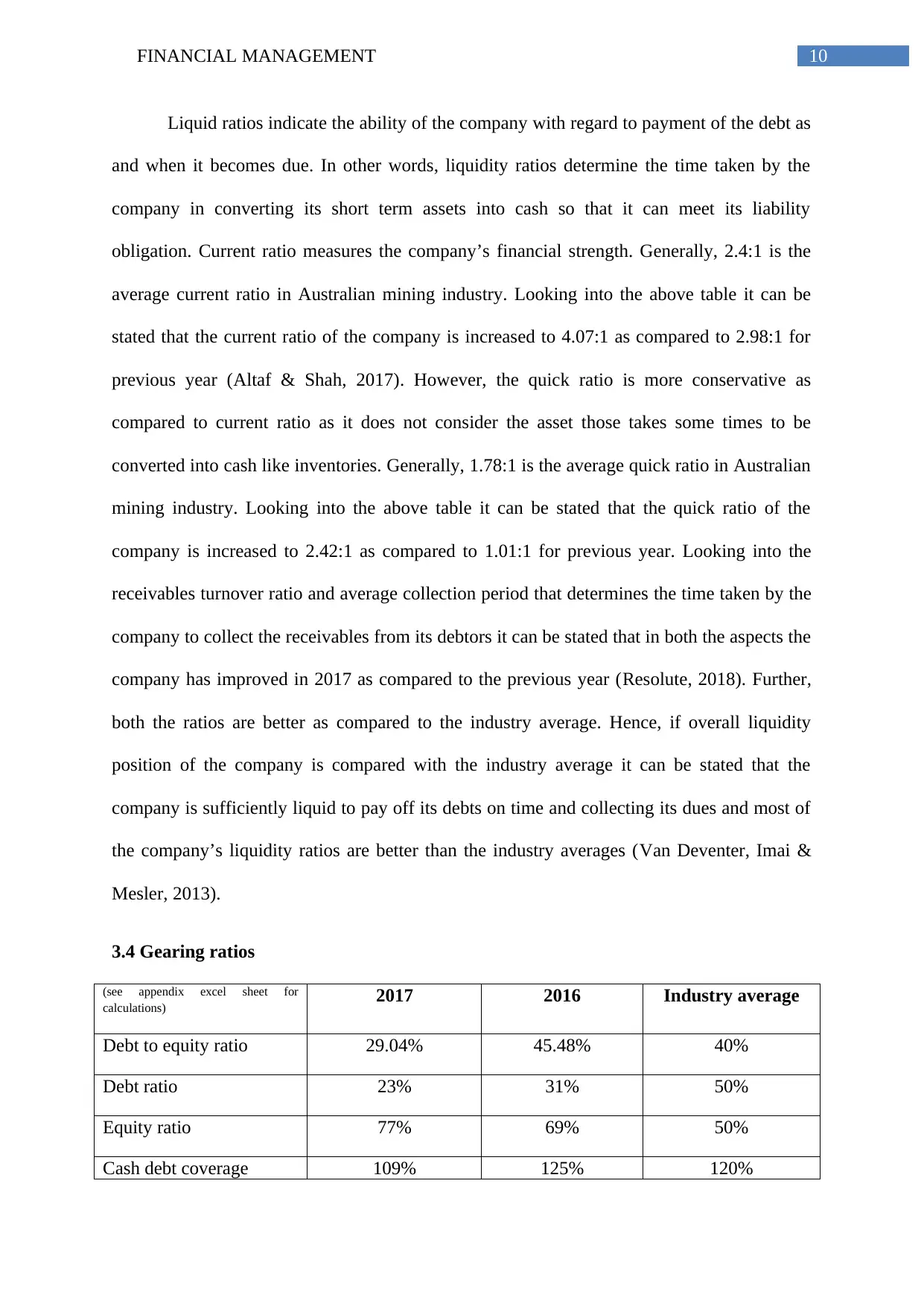
Liquid ratios indicate the ability of the company with regard to payment of the debt as
and when it becomes due. In other words, liquidity ratios determine the time taken by the
company in converting its short term assets into cash so that it can meet its liability
obligation. Current ratio measures the company’s financial strength. Generally, 2.4:1 is the
average current ratio in Australian mining industry. Looking into the above table it can be
stated that the current ratio of the company is increased to 4.07:1 as compared to 2.98:1 for
previous year (Altaf & Shah, 2017). However, the quick ratio is more conservative as
compared to current ratio as it does not consider the asset those takes some times to be
converted into cash like inventories. Generally, 1.78:1 is the average quick ratio in Australian
mining industry. Looking into the above table it can be stated that the quick ratio of the
company is increased to 2.42:1 as compared to 1.01:1 for previous year. Looking into the
receivables turnover ratio and average collection period that determines the time taken by the
company to collect the receivables from its debtors it can be stated that in both the aspects the
company has improved in 2017 as compared to the previous year (Resolute, 2018). Further,
both the ratios are better as compared to the industry average. Hence, if overall liquidity
position of the company is compared with the industry average it can be stated that the
company is sufficiently liquid to pay off its debts on time and collecting its dues and most of
the company’s liquidity ratios are better than the industry averages (Van Deventer, Imai &
Mesler, 2013).
3.4 Gearing ratios
(see appendix excel sheet for
calculations) 2017 2016 Industry average
Debt to equity ratio 29.04% 45.48% 40%
Debt ratio 23% 31% 50%
Equity ratio 77% 69% 50%
Cash debt coverage 109% 125% 120%
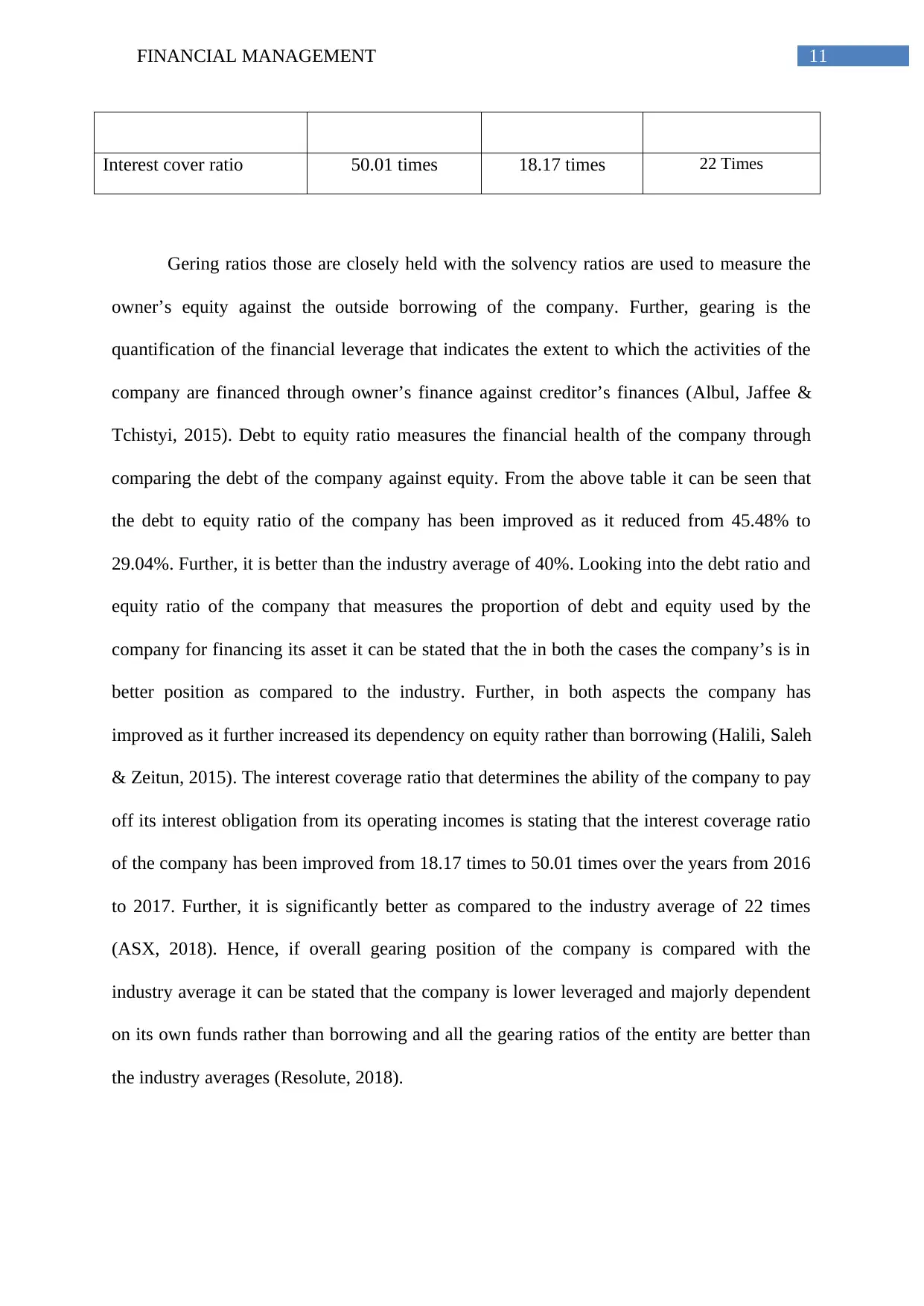
Interest cover ratio 50.01 times 18.17 times 22 Times
Gering ratios those are closely held with the solvency ratios are used to measure the
owner’s equity against the outside borrowing of the company. Further, gearing is the
quantification of the financial leverage that indicates the extent to which the activities of the
company are financed through owner’s finance against creditor’s finances (Albul, Jaffee &
Tchistyi, 2015). Debt to equity ratio measures the financial health of the company through
comparing the debt of the company against equity. From the above table it can be seen that
the debt to equity ratio of the company has been improved as it reduced from 45.48% to
29.04%. Further, it is better than the industry average of 40%. Looking into the debt ratio and
equity ratio of the company that measures the proportion of debt and equity used by the
company for financing its asset it can be stated that the in both the cases the company’s is in
better position as compared to the industry. Further, in both aspects the company has
improved as it further increased its dependency on equity rather than borrowing (Halili, Saleh
& Zeitun, 2015). The interest coverage ratio that determines the ability of the company to pay
off its interest obligation from its operating incomes is stating that the interest coverage ratio
of the company has been improved from 18.17 times to 50.01 times over the years from 2016
to 2017. Further, it is significantly better as compared to the industry average of 22 times
(ASX, 2018). Hence, if overall gearing position of the company is compared with the
industry average it can be stated that the company is lower leveraged and majorly dependent
on its own funds rather than borrowing and all the gearing ratios of the entity are better than
the industry averages (Resolute, 2018).
⊘ This is a preview!⊘
Do you want full access?
Subscribe today to unlock all pages.

Trusted by 1+ million students worldwide
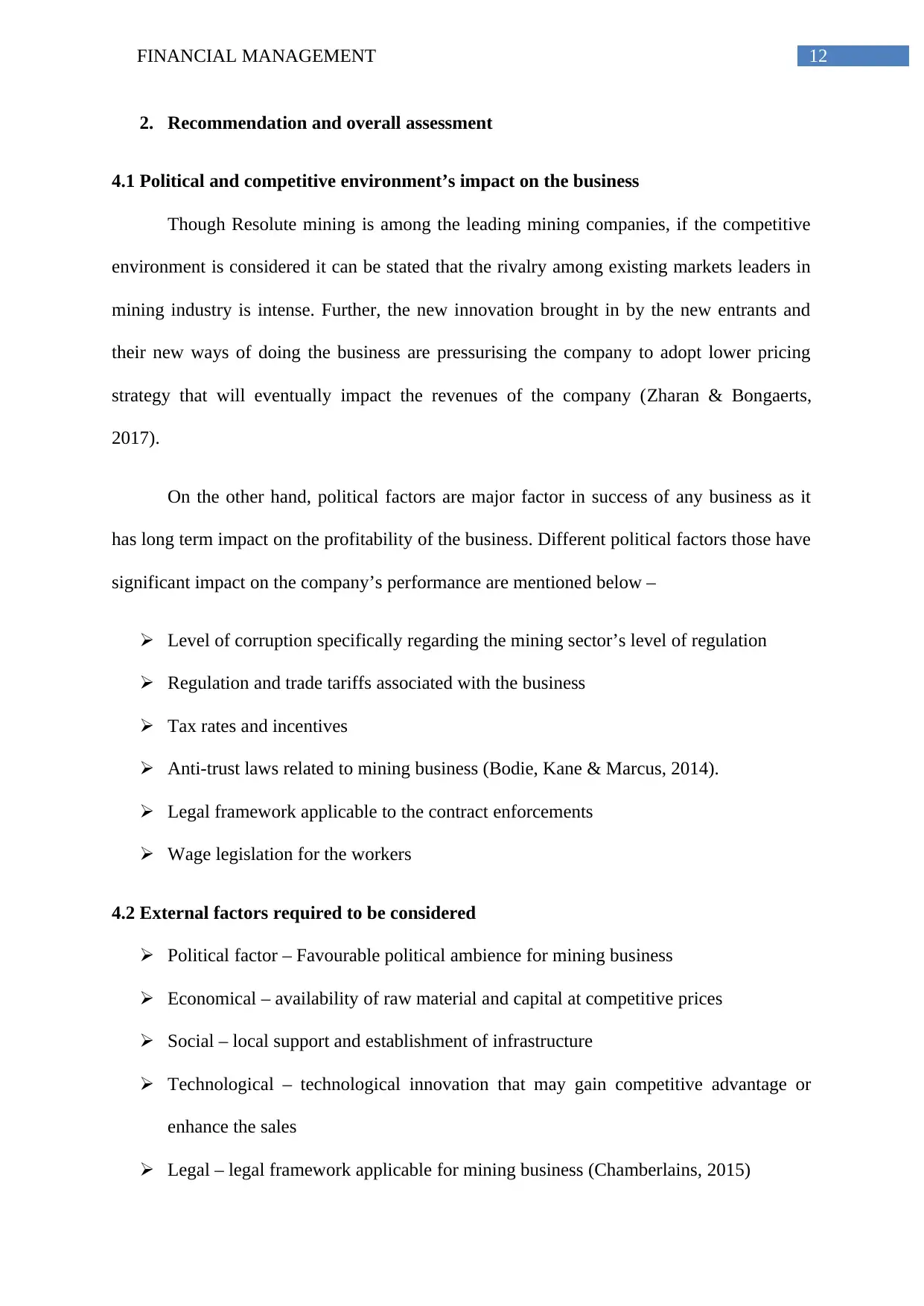
2. Recommendation and overall assessment
4.1 Political and competitive environment’s impact on the business
Though Resolute mining is among the leading mining companies, if the competitive
environment is considered it can be stated that the rivalry among existing markets leaders in
mining industry is intense. Further, the new innovation brought in by the new entrants and
their new ways of doing the business are pressurising the company to adopt lower pricing
strategy that will eventually impact the revenues of the company (Zharan & Bongaerts,
2017).
On the other hand, political factors are major factor in success of any business as it
has long term impact on the profitability of the business. Different political factors those have
significant impact on the company’s performance are mentioned below –
Level of corruption specifically regarding the mining sector’s level of regulation
Regulation and trade tariffs associated with the business
Tax rates and incentives
Anti-trust laws related to mining business (Bodie, Kane & Marcus, 2014).
Legal framework applicable to the contract enforcements
Wage legislation for the workers
4.2 External factors required to be considered
Political factor – Favourable political ambience for mining business
Economical – availability of raw material and capital at competitive prices
Social – local support and establishment of infrastructure
Technological – technological innovation that may gain competitive advantage or
enhance the sales
Legal – legal framework applicable for mining business (Chamberlains, 2015)
Paraphrase This Document
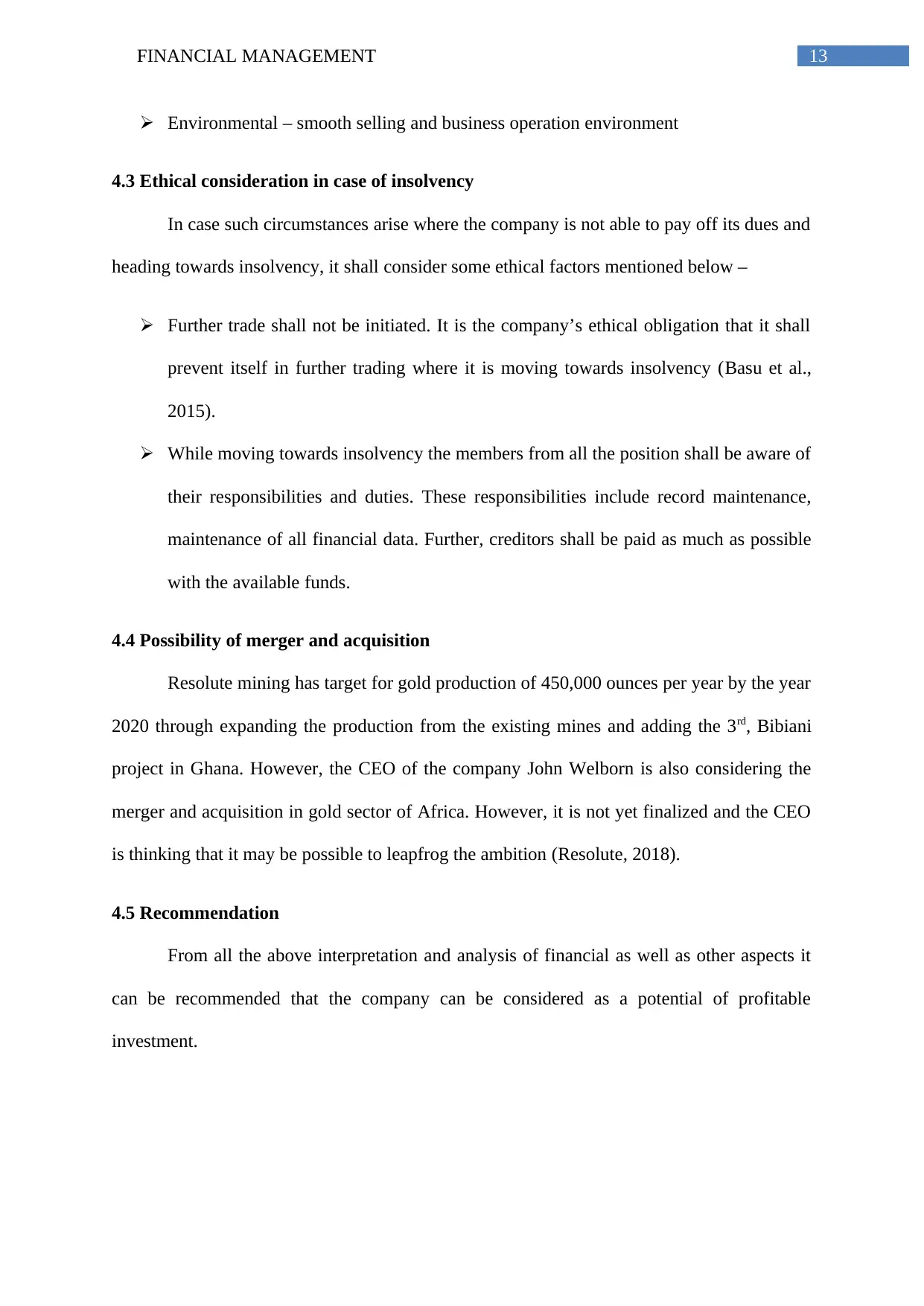
Environmental – smooth selling and business operation environment
4.3 Ethical consideration in case of insolvency
In case such circumstances arise where the company is not able to pay off its dues and
heading towards insolvency, it shall consider some ethical factors mentioned below –
Further trade shall not be initiated. It is the company’s ethical obligation that it shall
prevent itself in further trading where it is moving towards insolvency (Basu et al.,
2015).
While moving towards insolvency the members from all the position shall be aware of
their responsibilities and duties. These responsibilities include record maintenance,
maintenance of all financial data. Further, creditors shall be paid as much as possible
with the available funds.
4.4 Possibility of merger and acquisition
Resolute mining has target for gold production of 450,000 ounces per year by the year
2020 through expanding the production from the existing mines and adding the 3rd, Bibiani
project in Ghana. However, the CEO of the company John Welborn is also considering the
merger and acquisition in gold sector of Africa. However, it is not yet finalized and the CEO
is thinking that it may be possible to leapfrog the ambition (Resolute, 2018).
4.5 Recommendation
From all the above interpretation and analysis of financial as well as other aspects it
can be recommended that the company can be considered as a potential of profitable
investment.
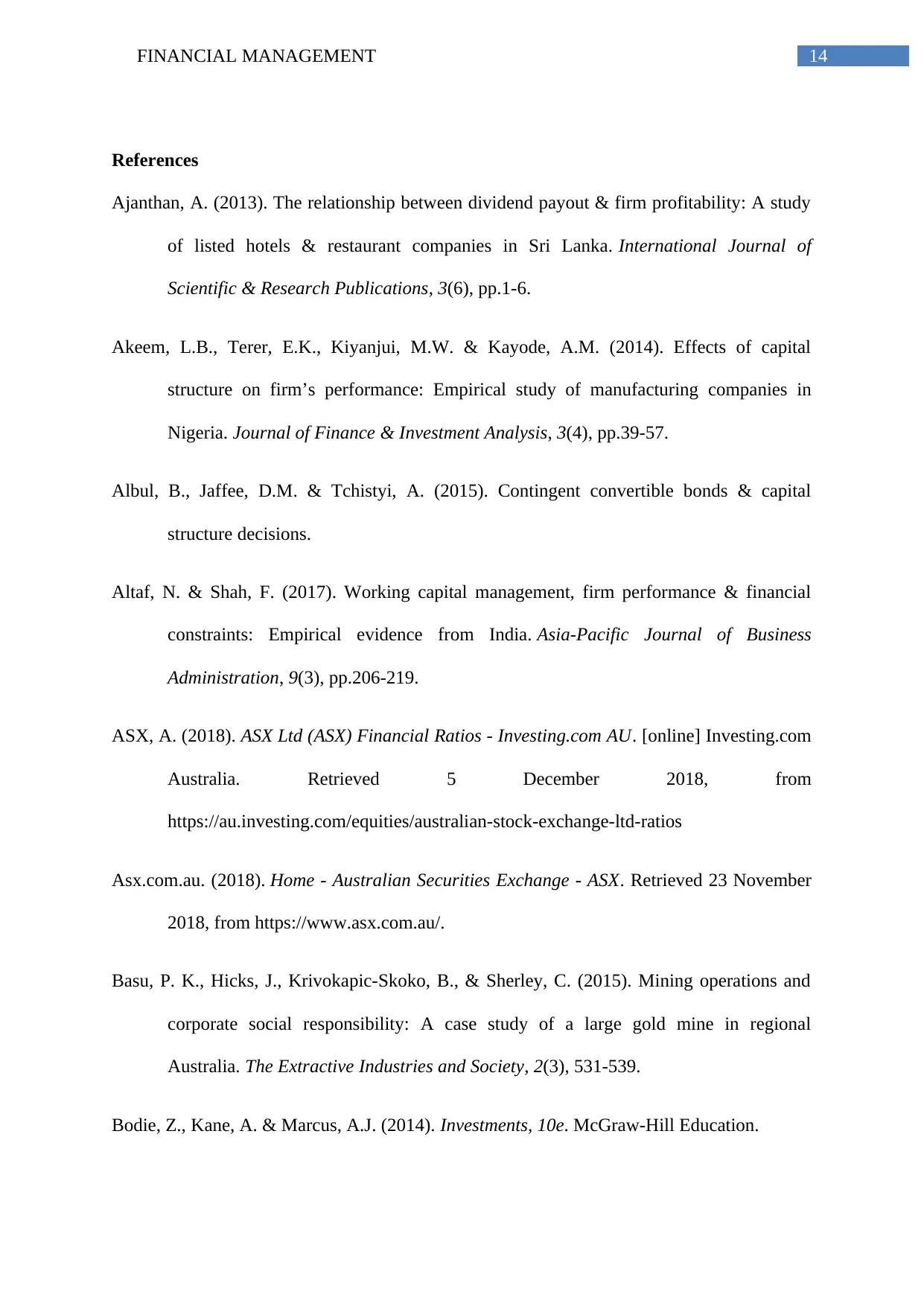
References
Ajanthan, A. (2013). The relationship between dividend payout & firm profitability: A study
of listed hotels & restaurant companies in Sri Lanka. International Journal of
Scientific & Research Publications, 3(6), pp.1-6.
Akeem, L.B., Terer, E.K., Kiyanjui, M.W. & Kayode, A.M. (2014). Effects of capital
structure on firm’s performance: Empirical study of manufacturing companies in
Nigeria. Journal of Finance & Investment Analysis, 3(4), pp.39-57.
Albul, B., Jaffee, D.M. & Tchistyi, A. (2015). Contingent convertible bonds & capital
structure decisions.
Altaf, N. & Shah, F. (2017). Working capital management, firm performance & financial
constraints: Empirical evidence from India. Asia-Pacific Journal of Business
Administration, 9(3), pp.206-219.
ASX, A. (2018). ASX Ltd (ASX) Financial Ratios - Investing.com AU. [online] Investing.com
Australia. Retrieved 5 December 2018, from
https://au.investing.com/equities/australian-stock-exchange-ltd-ratios
Asx.com.au. (2018). Home - Australian Securities Exchange - ASX. Retrieved 23 November
2018, from https://www.asx.com.au/.
Basu, P. K., Hicks, J., Krivokapic-Skoko, B., & Sherley, C. (2015). Mining operations and
corporate social responsibility: A case study of a large gold mine in regional
Australia. The Extractive Industries and Society, 2(3), 531-539.
Bodie, Z., Kane, A. & Marcus, A.J. (2014). Investments, 10e. McGraw-Hill Education.
⊘ This is a preview!⊘
Do you want full access?
Subscribe today to unlock all pages.

Trusted by 1+ million students worldwide
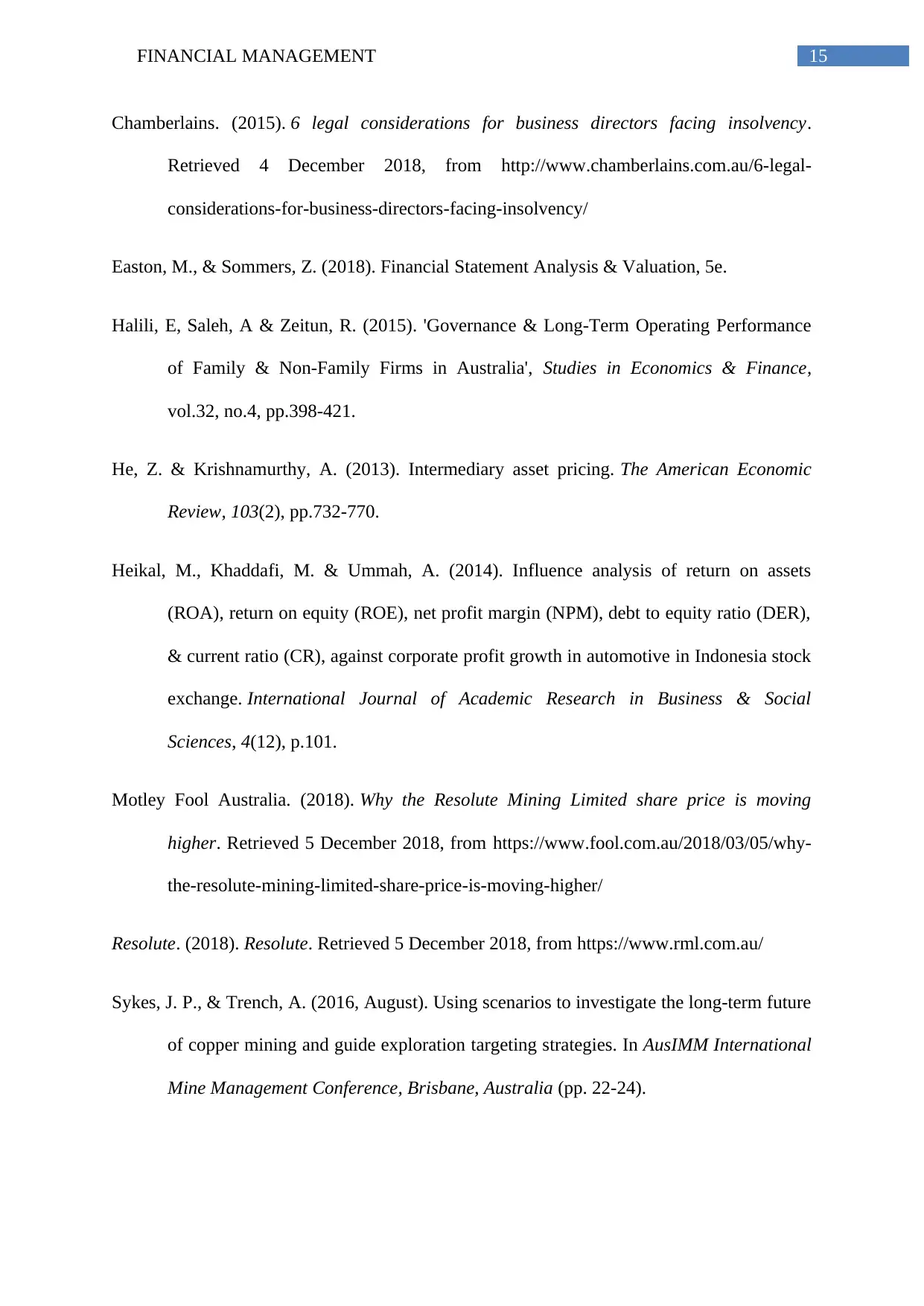
Chamberlains. (2015). 6 legal considerations for business directors facing insolvency.
Retrieved 4 December 2018, from http://www.chamberlains.com.au/6-legal-
considerations-for-business-directors-facing-insolvency/
Easton, M., & Sommers, Z. (2018). Financial Statement Analysis & Valuation, 5e.
Halili, E, Saleh, A & Zeitun, R. (2015). 'Governance & Long-Term Operating Performance
of Family & Non-Family Firms in Australia', Studies in Economics & Finance,
vol.32, no.4, pp.398-421.
He, Z. & Krishnamurthy, A. (2013). Intermediary asset pricing. The American Economic
Review, 103(2), pp.732-770.
Heikal, M., Khaddafi, M. & Ummah, A. (2014). Influence analysis of return on assets
(ROA), return on equity (ROE), net profit margin (NPM), debt to equity ratio (DER),
& current ratio (CR), against corporate profit growth in automotive in Indonesia stock
exchange. International Journal of Academic Research in Business & Social
Sciences, 4(12), p.101.
Motley Fool Australia. (2018). Why the Resolute Mining Limited share price is moving
higher. Retrieved 5 December 2018, from https://www.fool.com.au/2018/03/05/why-
the-resolute-mining-limited-share-price-is-moving-higher/
Resolute. (2018). Resolute. Retrieved 5 December 2018, from https://www.rml.com.au/
Sykes, J. P., & Trench, A. (2016, August). Using scenarios to investigate the long-term future
of copper mining and guide exploration targeting strategies. In AusIMM International
Mine Management Conference, Brisbane, Australia (pp. 22-24).
Paraphrase This Document
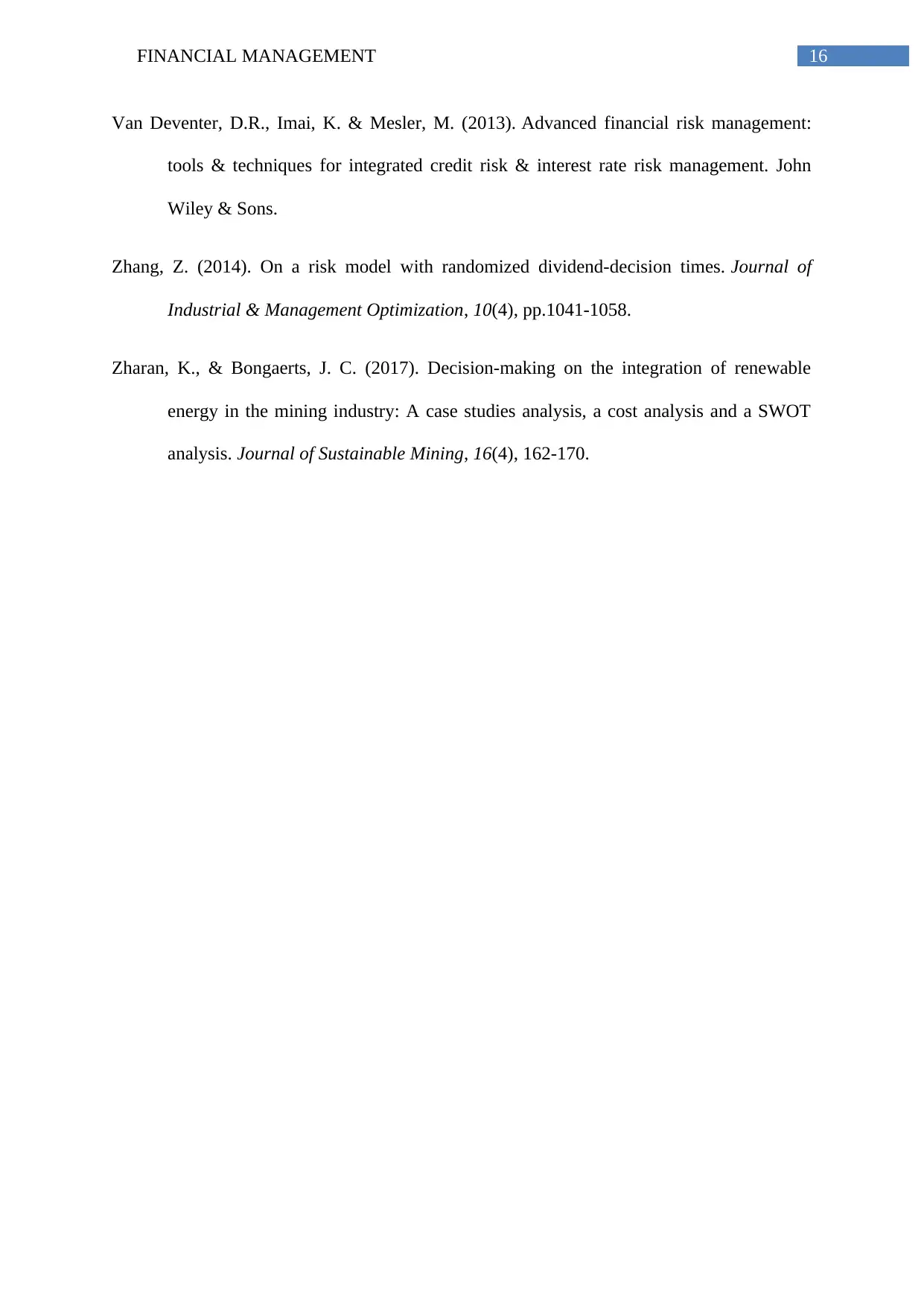
Van Deventer, D.R., Imai, K. & Mesler, M. (2013). Advanced financial risk management:
tools & techniques for integrated credit risk & interest rate risk management. John
Wiley & Sons.
Zhang, Z. (2014). On a risk model with randomized dividend-decision times. Journal of
Industrial & Management Optimization, 10(4), pp.1041-1058.
Zharan, K., & Bongaerts, J. C. (2017). Decision-making on the integration of renewable
energy in the mining industry: A case studies analysis, a cost analysis and a SWOT
analysis. Journal of Sustainable Mining, 16(4), 162-170.
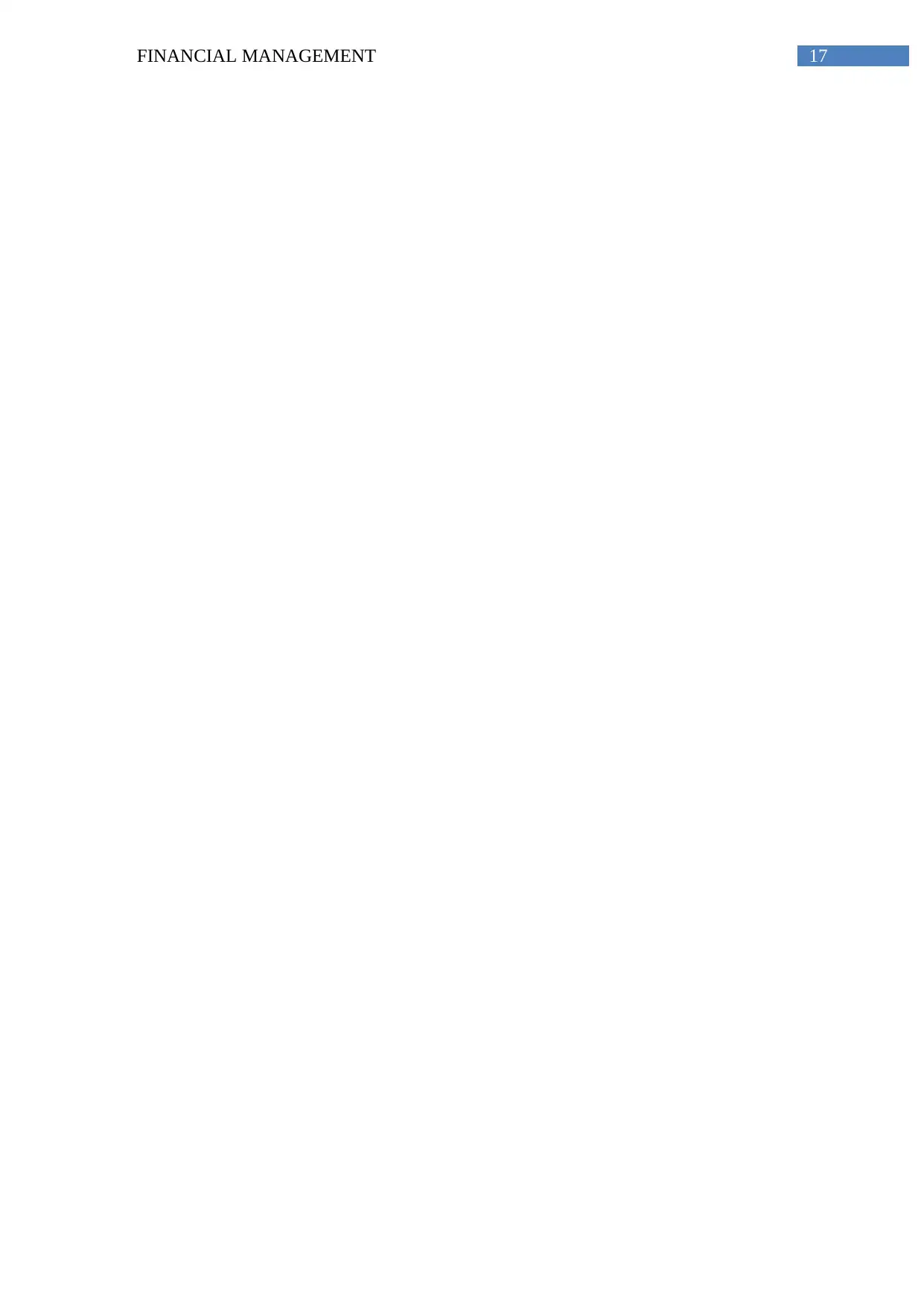
⊘ This is a preview!⊘
Do you want full access?
Subscribe today to unlock all pages.

Trusted by 1+ million students worldwide
Related Documents
Your All-in-One AI-Powered Toolkit for Academic Success.
+13062052269
info@desklib.com
Available 24*7 on WhatsApp / Email
![[object Object]](/_next/static/media/star-bottom.7253800d.svg)
© 2024 | Zucol Services PVT LTD | All rights reserved.



